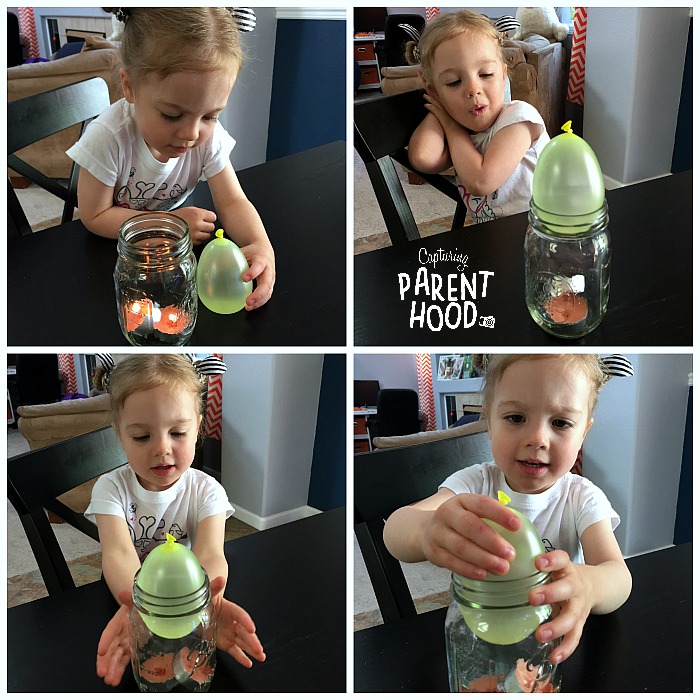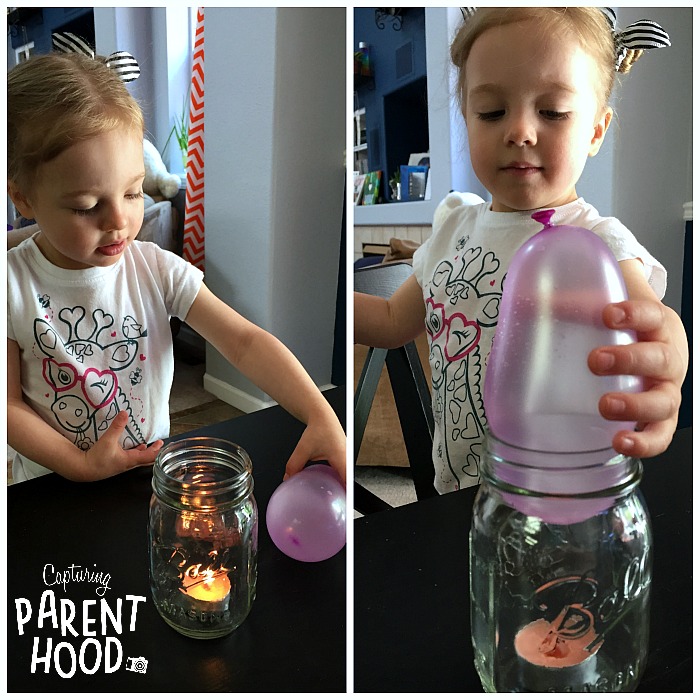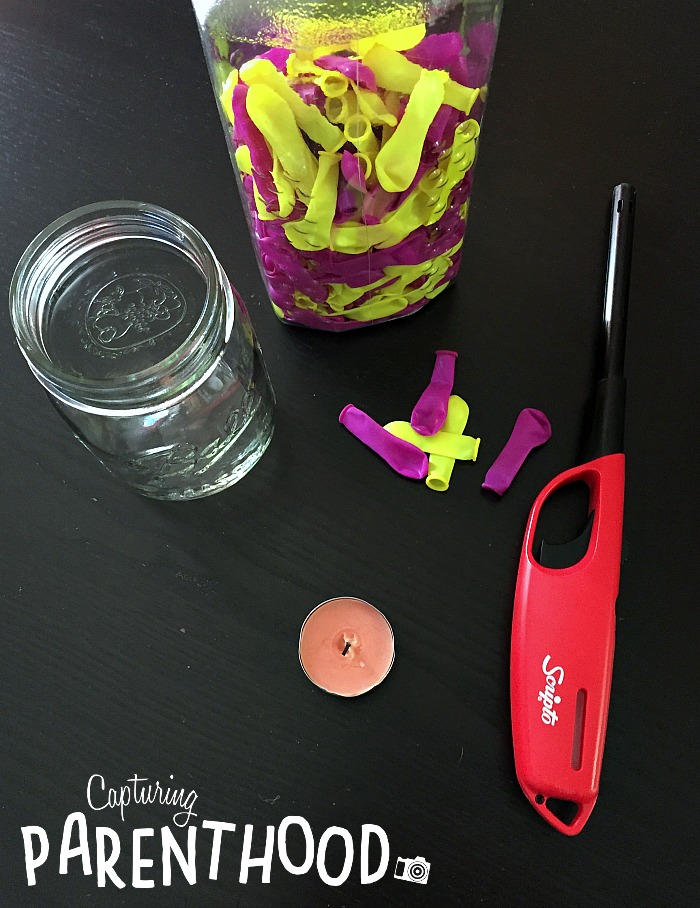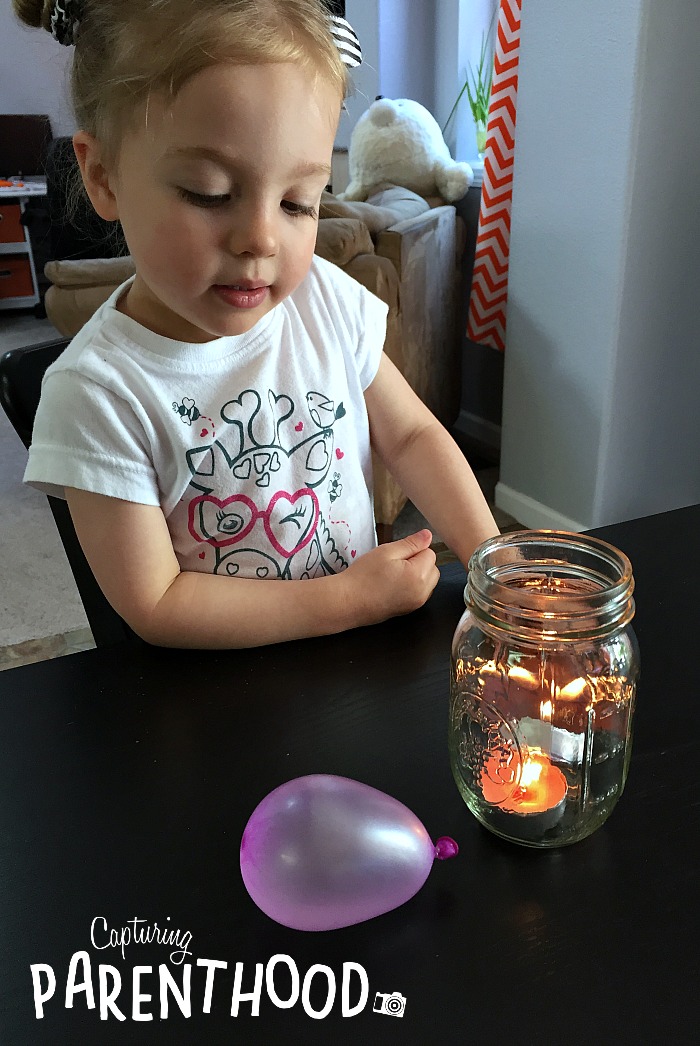Water balloons are a summer staple. I have numerous happy memories of water balloon fights during my childhood. Simply put…water balloons are cheap, fun, and they provide a great way to cool off on a hot summer day. Our little nugget is equally ecstatic about water balloons, and we’ve already had tons of fun tossing them around in the backyard this summer…including a rousing game of water balloon baseball! Despite all of our outdoor water balloon shenanigans, we’ve also recently discovered an entertaining indoor water balloon activity…this Water Balloon in a Jar Experiment!

Did you know that it’s possible to suck a water balloon into a jar? Yep! That’s right. You can set a full water balloon on top of an open jar (it’s obviously too large to fit through the opening), and with one extra little touch of magic, the water balloon will slide right on in. It’s all due to a change in air pressure.
I initially came across this gem of a science experiment over on @thedadlab Instagram feed. And I must admit, we had a bit of trial and error when it came time to getting our water balloon into the jar. In the early stages of our experiment, our water balloon kept getting stuck…halfway in and halfway out of the jar. But a true scientific experiment is always one with trial and error…a means of testing several different hypotheses. I was actually glad that our very first balloon didn’t just automatically sink into the jar, because it provided a wonderful opportunity for us to don our thinking caps, and try to discover why that was the case…and what we might want to try differently during our next attempt.

We hypothesized that perhaps we had over-filled our first water balloon…and we were correct in that assumption. You want to make sure to fill the water balloon so that it is just slightly larger than the jar opening. That being said, testing various-sized water balloons is a wonderful addition to this easy experiment. We also pondered whether or not we were creating enough heat in the jar before we placed the balloon on top. We decided to add one more tealight candle to the bottom of the jar.
With two candles and a smaller water balloon, we finally had success! Our little nugget was so excited!
Water Balloon in a Jar Experiment
Supplies:

- Water Balloon(s)
- Glass Jar/Bottle
- Tealight Candles
- Lighter
Instructions:

- Fill the water balloon so that it is just a bit larger than the opening of your glass jar. Tie the balloon securely in a knot.
- Place one or two tealight candles in the bottom of the jar.
- Light the candles. Note: This step should be done by an adult, or with adult supervision.
- Place the water balloon on top of the jar opening.
- Sit back and watch the magic happen!
- Repeat as many times as your heart desires. 🙂
As I mentioned above, the “magic” behind this simple science experiment is actually air pressure. When the candles are lit, they cause the jar to heat up. As the jar heats, the air inside the jar expands. When the water balloon is placed over the top of the jar, oxygen will no longer be able to enter the jar. A lack of oxygen will cause the candle flames to burn out, and the air inside the jar will begin to cool and contract…causing the water balloon to drop down into the jar. It would appear as though the water balloon is being sucked down into the jar, but in reality…the air pressure outside of the jar becomes greater than the air pressure inside of the jar…thus, it’s actually the air pressure of the room that pushes the water balloon down inside the jar!
Despite all of our unsuccessful attempts (before discovering the right water balloon-fullness to jar-opening ratio) this simple experiment was both exciting and enjoyable. Our little nugget was so enthralled…she sat at the dining room table for over an hour, experimenting and testing like a mad little scientist. 🙂
We love doing fun and simple science experiments and this Water Balloon in a Jar Experiment did not disappoint. If you’re looking for another engaging balloon-themed experiment, make sure to check out our Baking Soda & Vinegar Balloon Experiment!




